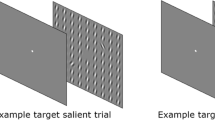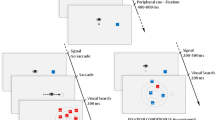Abstract
When looking for an object, we identify it by selectively focusing our attention to a specific feature, known as feature-based attention. This basic attentional system has been reported in young children; however, little is known of whether infants could use feature-based attention. We have introduced a newly developed anticipation-looking task, where infants learned to direct their attention endogenously to a specific feature based on the learned feature (color or orientation), in 60 preverbal infants aged 7–8 months. We found that preverbal infants aged 7–8 months can direct their attention endogenously to the specific target feature among irrelevant features, thus showing the feature-based attentional selection. Experiment 2 bolstered this finding by demonstrating that infants directed their attention depending on the familiarized feature that belongs to a never-experienced object. These results that infants can form anticipation by color and orientation reflect they could drive their attention through feature-based selection.



Similar content being viewed by others
Data availability
The data that support the findings of this study are available from the corresponding author, S. T., upon request.
References
Adler SA, Gallego P (2014) Search asymmetry and eye movements in infants and adults. Atten Percept Psychophys 76:1590–1608. https://doi.org/10.3758/s13414-014-0667-6
Adler SA, Haith MM (2003) The nature of infants’ visual expectations for event content. Infancy 4:389–421. https://doi.org/10.1207/S15327078IN0403_05
Adler SA, Orprecio J (2006) The eyes have it: visual pop-out in infants and adults. Dev Sci 9:189–206. https://doi.org/10.1111/j.1467-7687.2006.00479.x
Bertin E, Bhatt RS (2001) Dissociations between featural versus conjunction-based texture processing in infancy: analyses of three potential contributing factors. J Exp Child Psychol 78:291–311. https://doi.org/10.1006/jecp.2000.2568
Brown AM, Lindsey DT (2013) Infant color vision and color preferences: a tribute to Davida Teller. Vis Neurosci 30:243–250. https://doi.org/10.1017/S0952523813000114
Bulf H, Valenza E (2013) Object-based visual attention in 8-month-old infants: evidence from an eye-tracking study. Dev Psychol 49:1909–1918. https://doi.org/10.1037/a0031310
Chien SHL, Bronson-Castain K, Palmer J, Teller DY (2006) Lightness constancy in 4-month-old infants. Vision Res 46:2139–2148. https://doi.org/10.1016/j.visres.2005.11.027
Coldren JT, Haaf RA (2000) Asymmetries in infants’ attention to the presence or absence of features. J Genet Psychol 161:420–434. https://doi.org/10.1080/00221320009596722
Dannemiller JL, Hanko SA (1987) A test of color constancy in 4-month-old human infants. J Exp Child Psychol 44:255–267. https://doi.org/10.1016/0022-0965(87)90033-6
Emberson LL, Richards JE, Aslin RN (2015) Top-down modulation in the infant brain: learning-induced expectations rapidly affect the sensory cortex at 6 months. Proc Natl Acad Sci 112:9585–9590. https://doi.org/10.1073/pnas.1510343112
Frick JE, Colombo J, Saxon TF (1999) Individual and developmental differences in disengagement of fixation in early infancy. Child Dev 70:537–548. https://doi.org/10.1111/1467-8624.00039
Gerhardstein P, Rovee-Collier C (2002) The development of visual search in infants and very young children. J Exp Child Psychol 81:194–215. https://doi.org/10.1006/jecp.2001.2649
Goldknopf EJ, Gillespie-Lynch K, Marroquín AD, Nguyen BD, Johnson SP (2019) Spontaneous visual search during the first two years: improvement with age but no evidence of efficient search. Infant Behav Dev 57:101331. https://doi.org/10.1016/j.infbeh.2019.101331
Kaldy Z, Guillory SB, Blaser E (2016) Delayed match retrieval: a novel anticipation-based visual working memory paradigm. Dev Sci 19:892–900. https://doi.org/10.1111/desc.12335
Kouider S, Long B, Le Stanc L, Charron S, Fievet AC, Barbosa LS, Gelskov SV (2015) Neural dynamics of prediction and surprise in infants. Nat Commun 6:1–8. https://doi.org/10.1038/ncomms9537
Liu T (2019) Feature-based attention: effects and control. Curr Opin Psychol 29:187–192. https://doi.org/10.1016/j.copsyc.2019.03.013
Liu T, Mance I (2011) Constant spread of feature-based attention across the visual field. Vision Res 51:26–33. https://doi.org/10.1016/j.visres.2010.09.023
Liu S, Quinn PC, Wheeler A, Xiao N, Ge L, Lee K (2011) Similarity and difference in the processing of same- and other-race faces as revealed by eye tracking in 4- to 9-month-olds. J Exp Child Psychol 108:180–189. https://doi.org/10.1016/j.jecp.2010.06.008
Mandell DJ, Raijmakers MEJ (2012) Using a single feature to discriminate and form categories: the interaction between color, form and exemplar number. Infant Behav Dev 35:348–359. https://doi.org/10.1016/j.infbeh.2012.04.003
Maunsell JHR, Treue S (2006) Feature-based attention in visual cortex. Trends Neurosci 29:317–322. https://doi.org/10.1016/j.tins.2006.04.001
Mitsven SG, Cantrell LM, Luck SJ, Oakes LM (2018) Visual short-term memory guides infants’ visual attention. Cognition 177:189–197. https://doi.org/10.1016/j.cognition.2018.04.016
Nagata Y, Dannemiller JL (1996) The selectivity of motion-driven visual attention in infants. Child Dev 67:2608–2620. https://doi.org/10.1111/j.1467-8624.1996.tb01878.x
Needham A (2001) Object recognition and object segregation in 4.5-month-old infants. J Exp Child Psychol 78:3–24. https://doi.org/10.1006/jecp.2000.2598
Oakes LM (2017) Sample size, statistical power, and false conclusions in infant looking-time research. Infancy 22:436–469. https://doi.org/10.1111/infa.12186
Richards JE, Reynolds GD, Courage ML (2010) The neural bases of infant attention. Curr Dir Psychol Sci 19:41–46. https://doi.org/10.1177/0963721409360003
Ross-Sheehy S, Schneegans S, Spencer JP (2015) The infant orienting with attention task: assessing the neural basis of spatial attention in infancy. Infancy 20:467–506. https://doi.org/10.1111/infa.12087
Sun M, Wang E, Huang J, Zhao C, Guo J, Li D, Li S, Du B, Ding Y, Song Y (2018) Attentional selection and suppression in children and adults. Dev Sci 21:1–13. https://doi.org/10.1111/desc.12684
Tamis-LeMonda CS, McClure J (1995) Infant visual expectation in relation to feature learning. Infant Behav Dev 18:427–434. https://doi.org/10.1016/0163-6383(95)90032-2
Treisman AM, Gelade G (1980) A feture-integration theory of attention. Cogn Psychol 12:97–136. https://doi.org/10.1016/0010-0285(80)90005-5
Tsurumi S, Kanazawa S, Yamaguchi MK (2018) The development of object-based attention in infants. Infant Behav Dev 52:14–21. https://doi.org/10.1016/j.infbeh.2018.05.001
Tummeltshammer K, Amso D (2017) Top–down contextual knowledge guides visual attention in infancy. Dev Sci 21:e12599. https://doi.org/10.1111/desc.12599
Werchan DM, Amso D (2020) Top-down knowledge rapidly acquired through abstract rule learning biases subsequent visual attention in 9- month-old infants. Dev Cogn Neurosci 42:100761. https://doi.org/10.1016/j.dcn.2020.100761
Wilcox T (1999) Object individuation: infants’ use of shape, size, pattern, and color. Cognition 72:125–166. https://doi.org/10.1016/S0010-0277(99)00035-9
Wilcox T, Chapa C (2004) Priming infants to attend to color and pattern information in an individuation task. Cognition 90:265–302. https://doi.org/10.1016/S0010-0277(03)00147-1
Wolfe JM, Utochkin IS (2019) What is a preattentive feature? Curr Opin Psychol 29:19–26. https://doi.org/10.1016/j.copsyc.2018.11.005
Xiao NG, Emberson LL (2019) Infants use knowledge of emotions to augment face perception: evidence of top-down modulation of perception early in life. Cognition 193:104019. https://doi.org/10.1016/j.cognition.2019.104019
Xiao NG, Quinn PC, Wheeler A, Pascalis O, Lee K (2014) Natural, but not artificial, facial movements elicit the left visual field bias in infant face scanning. Neuropsychologia 62:175–183. https://doi.org/10.1016/j.neuropsychologia.2014.07.017
Yang J, Kanazawa S, Yamaguchi MK, Motoyoshi I (2015) Pre-constancy vision in infants report pre-constancy vision in infants. Curr Biol 25:3209–3212. https://doi.org/10.1016/j.cub.2015.10.053
Zhang W, Luck SJ (2009) Feature-based attention modulates feedforward visual processing. Nat Neurosci 12:24–25. https://doi.org/10.1038/nn.2223
Acknowledgements
We thank Yusuke Nakashima, Jiale Yang, Yuki Tsuji, Nanako Yamanaka, and Machi Sugai for their assistance with data collection. Special thanks to the infants and their parents for their kindness and cooperation.
Funding
This research was financially supported by Grant-in-Aid for JSPS Fellows (No.19J21422), Grant-in-Aid for Scientific Research on Innovative Areas “Construction of the Face-Body Studies in Transcultural Conditions” (No.17H06343) from MEXT, and Grant-in-Aid for Scientific Research (B) from the JSPS (No.19H01774).
Author information
Authors and Affiliations
Corresponding author
Ethics declarations
Conflict of interest
The authors declare no competing interests.
Ethical approval
This study was approved by the ethical committee of Chuo University.
Additional information
Communicated by Bill J Yates.
Publisher's Note
Springer Nature remains neutral with regard to jurisdictional claims in published maps and institutional affiliations.
Supplementary Information
Below is the link to the electronic supplementary material.
Supplementary file1 (MP4 59 KB)
Supplementary file2 (MP4 55 KB)
Rights and permissions
Springer Nature or its licensor holds exclusive rights to this article under a publishing agreement with the author(s) or other rightsholder(s); author self-archiving of the accepted manuscript version of this article is solely governed by the terms of such publishing agreement and applicable law.
About this article
Cite this article
Tsurumi, S., Kanazawa, S., Yamaguchi, M.K. et al. Infants’ anticipatory eye movements: feature-based attention guides infants’ visual attention. Exp Brain Res 240, 2277–2284 (2022). https://doi.org/10.1007/s00221-022-06428-1
Received:
Accepted:
Published:
Issue Date:
DOI: https://doi.org/10.1007/s00221-022-06428-1




